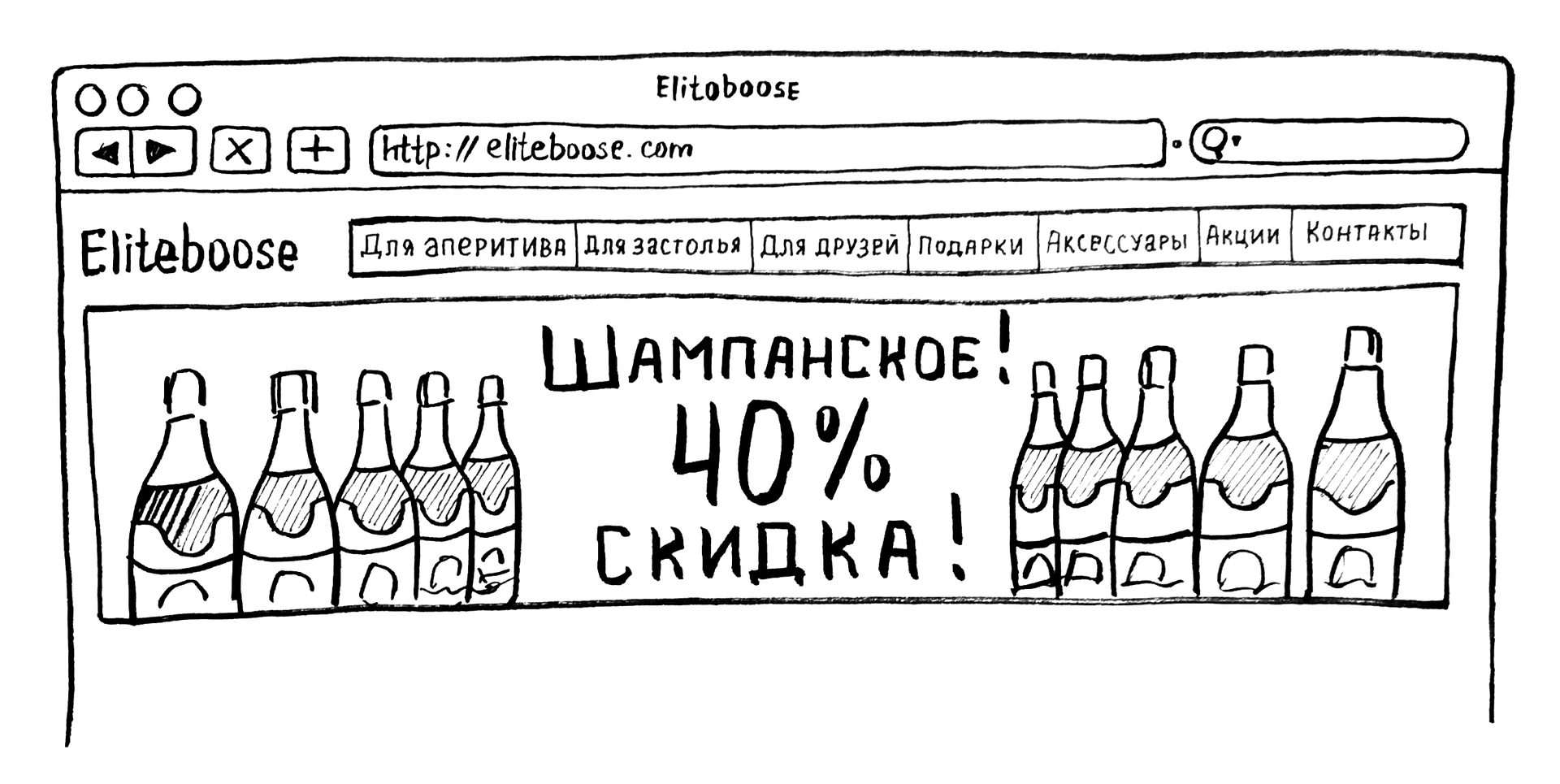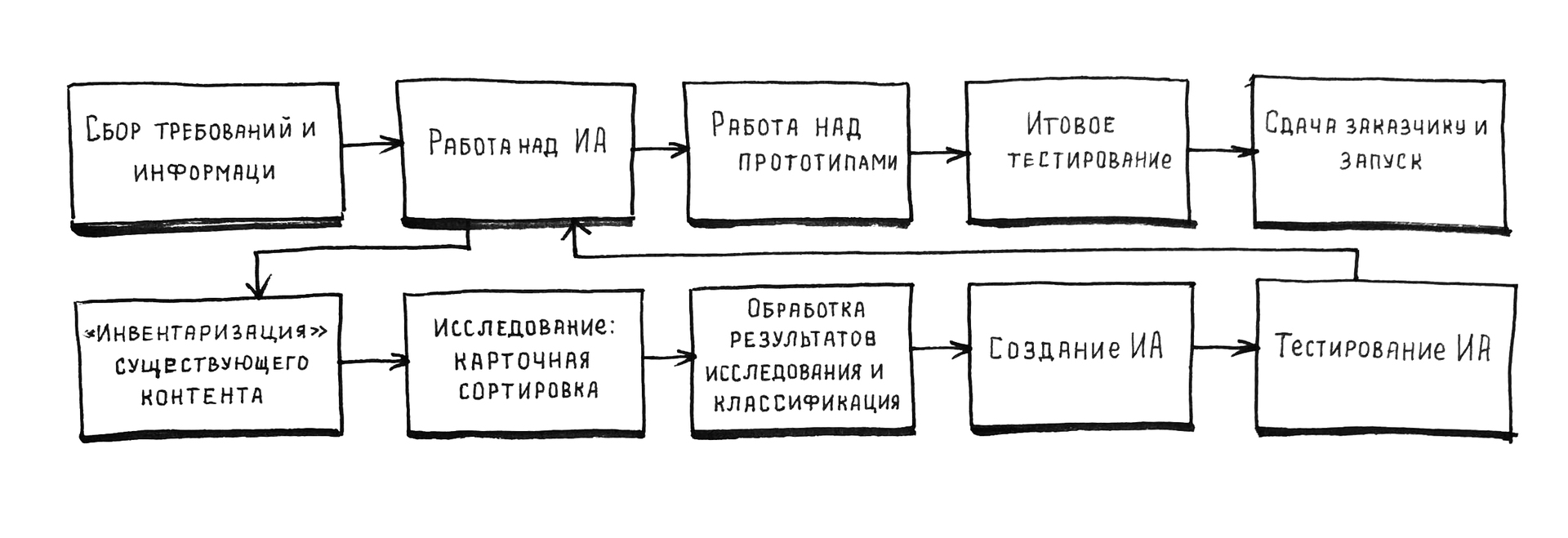We design information architecture for e-commerce. Part 1

It is time to think about the role of information in the design of interaction and its architecture, features and how to work on it.
Most of the time, we design interfaces and explore their perception by users. But it must be borne in mind that most of the interfaces are not an end in themselves, but merely intermediaries in the interaction between a person and information. Therefore, it is fair to pay considerable attention to the information itself, its architecture, and the human perception of information. Today we will talk about information architecture (hereinafter - IA ).
For impatient or those who have little time: the results are briefly and interesting links at the end of the text.
')
Let's start with the obvious.
Obvious # 1: People need information to make decisions.
Evidence # 2: Information may be:
- Incomplete - it is not enough to meet the information requests of the user;
- Incorrect - it does not correspond to reality;
- Excessive - its too much and / or it is too difficult for the user to perceive;
- Irrelevant - it suffices, it is correct, simple enough for perception, but ... useless. For many reasons.
Evidence # 3: In any of the above cases, all the work on beauty, elegance and functionality of the information presentation interfaces loses its meaning. For example, with false information, the ideal interface will allow the user to quickly make a false decision.
Evidence # 4: Information is organized into a structure that has an architecture.
Evidence # 5, final: If the user does not find the necessary information or does not perceive it, the customer or company loses profit.
In the course of my work as a UX designer in the field of e-commerce, I was faced with a variety of ideas about information architecture. For the most part, it is perceived as one of the non-essential aspects of interaction design. As a result, the work on the information architecture is not allocated neither resources nor time. Users end up suffering, and companies lose a significant share of revenue.
Perhaps this is the main reason that prompted me to write an article that I bring to your attention. It is divided into several chapters in which I propose to consider the following questions:
- What is information architecture as a phenomenon, its place in the general process of interaction design;
- What are the specifics of working on information architecture for ecommerce;
- How we make decisions. A bit of psychology;
- How to design information architecture in practice.
To tell in detail about everything in the framework of one article is an impossible goal, so please leave suggestions and questions in the comments, and I will try to answer everything in the following parts.
Well, let's get started.
Why work on information architecture?
All matches with real characters, services
and products - random.
What happened to Ivan Vladimirovich
Ivan Vladimirovich returned home at midnight due to the fact that he was very late at work. In principle, he lingered quite often. This would not have bothered him so much if it were not for one circumstance: in the evening he was informed that their new boss would have a birthday tomorrow.
With the gift itself, Ivan decided quickly enough: it was known that from the alcoholic chef prefers good rum. But the situation as a whole was hopeless. Numerous elite alcohol shops known to him were closed, and the celebration would begin in the morning. Apparently, you have to use the online store. The Internet did not like Ivan Vladimirovich and used it mainly for reading news. Reluctantly, he sat down at his laptop and began to search.
His choice was at the Eliteboose.com store, about which he had heard that the best choice was liquor. At first glance, Ivan Vladimirovich was impressed by the stylish and neat design of the site.

Running his eyes on the menu, he thought. Rum was not one of his favorite drinks, and he understood it, frankly, it does not matter. If you think rum falls into any of these categories, with the exception of an aperitif. After a brief reflection, Ivan Vladimirovich decided to go to the "Gifts", as the most appropriate menu item for his needs.
He looked through the proposed products for about 15 minutes. To his disappointment, there was no rum in the list of goods. And the offered gifts were far both from his needs and from financial possibilities.
I was already very sleepy, but Ivan Vladimirovich made another attempt by going to another menu item - “For friends”. Among the numerous beer, vodka and liqueurs, he finally noticed a lonely rum, lurking at the end of the list. The Demo Anejo bottle was probably a good choice, but he was confused by the lack of choice. Yes, and whether his chef - the head of the department of one of the leading banks in the country - would appreciate a gift at a price of only $ 13.
Ivan Vladimirovich went to the balcony to smoke. Then he came back, sat down at the laptop and made the third and last attempt: he chose the menu item “For a feast”. And then the long-awaited miracle happened: he saw an impressive list of the most diverse rum of any price category. After reflecting on the list a couple of minutes, he added a fifteen-year-old rum Gran Demo Blender to the basket and easily passed the ordering procedure. Ivan Vladimirovich was pleased with himself, but the premonition of a colossal lack of sleep significantly poisoned the mood.
In the morning, Ivan Vladimirovich was finally convinced of the justification of his dislike for online stores. After drinking a couple of cups of coffee, he vowed to find out about upcoming events only in advance in order to buy gifts in regular stores calmly and without stress.
And now in numbers
In the above story, there is a problem with IA, albeit exaggerated. At Eliteboose.com we see unclearly defined and named categories, an unobvious classification of goods into categories.
We can state the fact that with Ivan Vladimirovich Eliteboose.com is very lucky. Our hero was a) stubborn enough not to score on the idea of buying rum in an online store, b) it’s enough in principle not to refuse to buy a gift in general and c) inert enough to go to a competing online store.
But, I believe, it would not be very far from reality that the assumption that most potential buyers would have left trying to find the right alcohol in Eliteboose.com after the first, or indeed after the second attempt. Thus, we can calculate the lost income of the store.
We are adapting the approach of Jared Spool (Jared Spool) , which he used to calculate the cost of passenger frustration from usability problems for the Amtrak transport company:
- We calculate the ideal potential income - Iideal = a * b , where a and b are the average check and the number of potential buyers (leads) per day
- We get the total under-received income - Iforgone = Iideal - (Iideal * x / 100) , where x is the share of refusals from the purchase in general
- We learn the cost of an error in an IA - IAcost = Iforgone * y / 100, $ 3,500 * 20/100 , where y is the share of failures due to the fault of the IA.
Example
Given:
- The average order check is $ 100 ;
- Number of potential buyers (leads) per day - 50 ;
- the share of refusals to purchase - 70% ;
- of them, due to the fault of the IA - 20% .
We consider:
- Ideal income - $ 100 * 50 = $ 5000 per day
- The total under-received income is $ 5000 - ($ 5000 * 70/100) = $ 3,500 per day
- The cost of an error in an AI is $ 3,500 * 20/100 = $ 700 per day
We conclude:
The cost of errors in IA is $ 700 per day, $ 21,000 per month or $ 252.000 per year.
In the case of corporate software, the loss in employee time spent will be no less significant.
But before moving on to solving a problem, the following question reasonably arises:
“And what do we mean by information architecture?”
What is information architecture?
Take an average IT employee and ask the question: what is an information architecture, and why is it needed? Among the answers that we receive, with variations may be the following:
- “Is this how information is organized? Where and what is? ";
- "Something of usability, for ease of use of the site?";
- “Similarly, the site map! Yes, of course it is useful ... I really do not use it ";
- "Navigation, like ... Well, how to navigate the site";
All the answers are related to reality, but different in terms of understanding the phenomena of IA. But most likely all the respondents will agree that a good IA is useful, and a bad one is harmful. If you ask your customers about this, the variability of opinions will increase significantly. And after studying the fundamental works on IA, the truth will become obvious that there are several understandings of IA, even among the information architects themselves.

Richard Saul Wurman
The father of information architecture, Richard Saul Wurman , provides the following definitions of information architecture:
- “Finding and organizing patterns inherent in the data. In order to make complex things simple, ";
- “Creating a structure or map of information to allow users to find their own personal path to knowledge”;
- "Occurring in the XXI century profession, focusing on clarity, understanding of man and the science of organizing information."
Peter Morvil and Louis Rosenfeld in the classic work on the Information Network on the Internet, give as many as four definitions:
- Combination of organization, objectification and navigation schemes implemented in the information system.
- Structural design of the information space, facilitating the execution of tasks and intuitive access to content.
- The art and science of structuring and classifying websites and intranets to make it easier for users to search for and manage information.
- Developing discipline and community of practitioners, which aims to spread the principles of design and architecture in digital spaces.
Donna Spencer joins Morville and Rosenfeld, who relies on their definitions in her Practical Guide to Information Architecture.
Despite the very broad understanding of the term, it would be nice to formulate the definition and understanding of an EA from the point of view of practice in designing interaction.
I suggest the following (which would not contradict the above approaches to understanding the IA):
“IA is a scheme for organizing site information”
Laconic and very abstract. Measurable indicators of the quality of IA should be quite specific:
- The speed of finding information (KPI: number of steps to find information or elapsed time);
- The quality of the information found (KPI: a qualitative indicator of the compliance of information with user expectations, from 1 to 10).
It should be noted that IA is always present in any application. The question is only in its accordance with the understanding and needs of the user.
Hence the question number two:
If it is so important, how to integrate the work on IA into the overall interaction design process?
How to work on information architecture?
The viewpoint of Dan Saffer , who, in his work “Designing for Interaction,” considers four practical approaches to interaction design, which I give below, is close to me. How appropriate to work on the EA in each of the approaches?
A. User-centered

Idea: the user knows better
Focus: Goals and needs of the user
The essence of the approach: The designer engages users in the workflow, starting from the very beginning and throughout the project. Constant consultations with users, testing after each design stage. In case of a conflict of opinions between the designer and the user regarding any interface element, the user's opinion has absolute priority.
Where used: large grocery companies, startups and digital agencies.
Features: The approach may be unsuitable for sites designed for a large number of users and with a wide positioning (because during the study, the designer will rely on the opinion of only a narrow circle of users).
Place of IA: Due to the specificity of the approach - the main focus on research - you can safely use the lion’s share of IA tools (I’ll write about the tools separately) without losing time and budget. The most costly part - a set of users studied - is paid in any case because they are already taking part in UX research and testing. Designing an IA will follow a classical pattern from top to bottom.
Subprocess of creating IA

Note: the “Card Sorting” research method is far from the only one. An excellent comparative review of IA research methods is described here by Jim Ross .
B. Activity-centered

Idea: We start from user tasks.
Focus: User activity.
The essence of the approach: Activities consist of actions and decisions. The designer explores the actions that the user makes and the decisions that he needs to take. Based on the study, but to a lesser extent than the previous approach. After this, it forms a list of tasks facing the user, and, based on them, proposes a solution.
Where used: Both startups and outsourcing companies.
Features: Due to the focus on the user's tactical tasks (Register, enter the password, refine the search parameters) there is a risk that the designer will not see the trees behind the trees (buy the product).
Place IA: You can also develop an IA in collaboration with users without much loss of time and budget. But you need to build on the user's tasks, and what information should help the user to solve each specific task in the course of its activities. Only after that will it make sense to move to a higher level. Thus, the design of IA will go from the bottom up.
Subprocess of creating IA

C. Systems design

Idea: The user is part of the surrounding system.
Focus: User environment.
The essence of the approach: mainly an analytical approach. The designer should focus on the context of use of the site. The state of the system, the environment, the goals of the system’s activities relative to the environment and the responses of the system to external disturbances are determined and modified.
Where used: Digital agencies, large food companies.
Features: It is advisable to use only in cases when a complex product or system of products is created. As a rule, the approach requires the work of a whole group of designers and designers.
Place of IA: direct research and design of IA here is replaced by work on the system architecture, with different tools and approaches.
D. "Brilliant" design (Genius design)

Idea: Designer - all over the head.
Focus: Own understanding of design, design heuristics (examples can be found in the Nielsen Norman Group ).
The essence of the approach: The designer independently designs the interaction, based on his experience and understanding of the question and referring to the specified heuristics.
Where used: outsourcing companies and startups.
Features: The entire design process and its results depend on the designer 100%.
Place of IA: Due to time and resource constraints, full-fledged research on IA is difficult to conduct. Therefore, designers periodically independently create information architecture schemes, in an arbitrary form, based on their understanding and needs of the project.
Subprocess of creating IA

In the case of designing information architecture for ecommerce projects, there are several specific points that we will look at in detail in the next chapter.
Let's sum up the intermediate results.
Results or in brief for those who are lazy
What
Information architecture (IA) is a scheme for organizing information.
As measured
- The speed of finding information;
- The quality of the information found.
Who came up with
Richard Saul Wurman.
What is the problem
Losses from "poor quality" IA are not very obvious, hidden in the form of lost income, but significant enough (they can reach half of the lost income and more).
As a consequence of their non-obviousness:
AIs are often sacrificed during the process of designing interaction design.
What's next
In the next chapter, we will look at building an information architecture for e-commerce, and the pitfalls of this process.
What to read
If you are interested in the topic, I recommend reading the following articles:
- A brief history of IA (English);
- Cases provided by the Institute of Information Architecture (English);
- Am I an information architect? (PDF, English);
- Top 10 errors in information architecture (English);
- A little about the method of card sorting (English);
- The difference between AI and navigation (English).
Or, if you are very interested, I offer you the following books:
- Information architecture on the Internet (P.Morvil and L.Rosenfeld, rus.) Is one of the basic books on IA, and among those few that have been translated into Russian;
- A Practical Guide to Information Architecture (D. Spencer, English) is also basic, but I found it only in the English version;
- The Pervasive Information Architecture: Designing Cross-Channel User Experiences (A.Resmini, L.Rosati, eng.) Is, in my opinion, an excellent book for “advanced” learning of an EA.
We design information architecture for e-commerce. Part 2
Source: https://habr.com/ru/post/239849/
All Articles